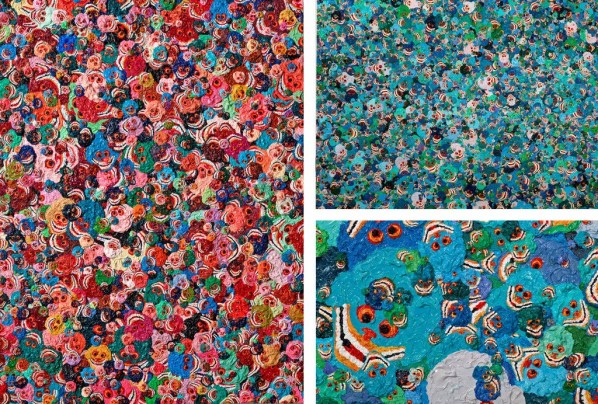
Mr. Zhang’s paintings “Poppy Field No. 5” (2011), left, and “Poppy Field No. 16” (2013), top right; a detail from the latter painting, bottom right.
Pace presents Zhang Huan: Poppy Fields, the artists’ first solo exhibition in New York since 2010. Poppy Fields features 18 never-before-seen paintings made from 2011 to 2013 that have occupied the artist’s practice for 3 years. The exhibition will be on view at 534 West 25th Street from September 20 through October 26. A catalogue with an essay by curator Kathryn Selig Brown accompanies the exhibition and includes photographs taken by the artist during his time in Tibet.
Poppy Fields features a series of vividly colored, oil on linen paintings that are uniquely intimate in scale and nature comparted the artist’s iconic large-scale Ash paintings and monumental sculptures. Zhang Huan employs a thick impasto technique and all-over style that engulfs the surface of each Poppy Field painting.Observed at a distance, each work presents a mesmerizing field of candy-colored pink, teal, lilac and sand, which appears to pulsate with energy. Only upon closer inspection does each burst of color transform from the abstract into figurative. Tiny faces with round eyes and wild Cheshire grins become evident in close view, a reference to ancient Tibetan dance masks.
Skulls are a recurring image in Zhang Huan’s work and stem from the artist’s early explorations in performance, inspired by the body and human form. In 2007, the artist completed his Skull series, large-scale paintings made of incense ash collected from sites of Buddhist ritual and ceremony. Many paintings were titled Renaissance in reference to Buddhist philosophies of rebirth rather than the finality of death.
In her essay, The Art of Impermanence: Zhang Huan and Tibetan Skulls, Kathryn Selig Brown points to Tibetan skulls as a “spiritual antidote of passion and vice,” used as ritual vessels and worn in crowns and garlands by tantric deities to defeat the power of the ego. Poppy Fields, the title of this new series, evokes the hallucinatory power of the poppy seed and its damaging effects.
Poppy Fields dramatically differ in palette, content and material from the artist’s well- know Ash series, yet Zhang Huan expresses a similar message about both series. In the artist’s own words, these paintings, “invite a new examination of our collective awareness and experience,” and express, “the birth, senility, illness and death of humanity.” They are a plea to reexamine and reverse lost values.Zhang Huan (b. 1965, China) is one of the most vital, influential and provocative contemporary artists working today. The layers of ideas the artist explored in his early performance art, conceived of as existential explorations and social commentaries, have carried through to the more traditional studio practice he embraced upon moving to Shanghai in 2005, after living and working for eight years in New York City. Zhang Huan lives and works in Shanghai, China.
Most recently Zhang Huan has been the subject of major solo exhibitions worldwide including this years’s Zhang Huan: Soul and Matter, Forte di Belvedere and Palazzo Vecchio, Florence, July 8—October 13, 2013 and Looking East, Facing West: The World of Zhang Huan, Frederik Meijer Gardens & Sculpture Park. Grand Rapids, Michigan, May 24—August 25, 2013.
Zhang Huan’s work is part of nearly 50 public collections worldwide, including Center of Contemporary Art, Malaga, Spain; Centre national d’art et de culture Georges Pompidou, Paris; Denver Art Museum; The Hara Museum of Contemporary Art, Tokyo; The Israel Museum, Jerusalem; The Metropolitan Museum of Art, New York; Museum of Contemporary Art, Barcelona; Museum of Contemporary Art, Los Angeles; Museum of Contemporary Art, San Diego; Museum of Fine Arts, Boston; The Museum of Modern Art, New York; National Gallery of Australia; Philadelphia Museum of Art; S.M.A.K., The Municipal Museum of Contemporary Art Gent, Belgium; Saatchi Collection, London; San Francisco Museum of Modern Art; Solomon R. Guggenheim Museum, New York; Storm King Art Center, New York; and Yale University Art Gallery, Connecticut, among other.
Copyright and Credit Information: Photograph courtesy Pace Gallery, ?Zhang Huan studio
For more information about Zhang Huan, please contact Concetta Duncan at 212.421.8987/cduncan@pacegallery.com. For general inquiries, please email newyork@pacegallery.com’ for reproduction requests, email reprorequest@pacegallery.com.
Courtesy of Zhang Huan and Pace Gallery, for further information please visit www.pacegallery.com.




























